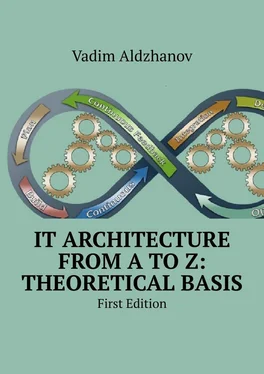• Project name;
• Project objectives;
• Project Manager;
• Project owner or stakeholders;
• Project team.
• Assignments consist of three subsections: the number , a short but meaningful title , and a description . It should contain specific statement activities to be carried out.
• Estimated start and termination dates;
• Project implementation schedule;
• Project estimate summarized at the assignment level;
• Metrics and criteria for achieving goals;
• Additional terms.
All projects involving financial aspects of profit may require a thorough assessment of the project impact on income and expenses, before the project is approved.
Schedule and progress is a chart indicating the start and finish dates and the planned duration for each work package. This schedule and progress is usually depicted as a Gantt chart and network graphs specifying the logical sequence of the execution of work packages. The planning process group includes the following processes:
• Developing a project management plan;
• Content management plan;
• Collecting requirements;
• Definition of content;
• Creating a hierarchical operational structure;
• Developing a schedule management plan;
• Definition of operations;
• Determining the sequence of operations;
• Evaluation of operational resource;
• Estimation of the operational duration;
• Scheduling;
• Developing a cost management plan;
• Estimating;
• Budgeting;
• Quality planning;
• Development of a human resources management plan;
• Communication planning;
• Risk management planning;
• Risk identification;
• Qualitative risk analysis;
• Quantitative risk analysis;
• Risk response planning;
• Procurement planning;
• Development of a stakeholder management plan.
This phase deals with the main project activities, i.e. writing the code, erecting the building etc. Following the developed plans leads to the previously defined content of the project, and the selected metrics are controlled. In the second part of this phase, the product is tested, it is checked for compliance with the customers and stakeholders’ requirements. During testing, the product deficiencies are identified and fixed.
This phase includes the allocation of responsibilities to carry out the assignments. Creating an effective group is both: an art and a science. To create an effective project team, one should consider not only the technical qualifications of the project manager and the members of the project team, but also their critical roles and interpersonal relationship. The selection of a project manager and team members will not be perfect – there is always a risk in any HR decision. The main goal when choosing a project manager is to appoint an experienced and competent person who is able to get the final result duly and meet the project requirements with the resources available. From this point of view, all the basic qualities of an effective project manager can be attributed to one of the following five categories:
• Education and experience;
• Leadership and strategic thinking;
• Technical competence;
• Ability to work with people;
• Proven managerial skills.
The choice of project team depends on the following factors:
• The objectives and goals of the project;
• The nature of the activities to be performed;
• the qualifications required for hiring, assigning, obtaining authority, control, communication and performing the required activities at each stage of the project;
• Availability of appropriate personnel in the organization where the project will be carried out.
It is important for the project manager and the members of the project team to know that the newly formed teams go through go through the five stages of team development which are:
• Forming stage takes place when the team first meets each other, breaks ice build relations.
• Storming stage is natural and not avoidable. The members of the team test each other, establish a sense of boundaries and trust.
• Norming stage implies developing the norms of behavior and acceptable unwritten rules obeyed by all members. Team members know what to expect from each other in the process.
• Performing stage takes place when the project team is ready to implement the project.
• Adjourning is the last stage when project is ending and the team members are moving off into different directions.
Reintegration of the project member is the process of introduction / withdrawal of the project member to / from the project. The project manager prepares the re-integration of employees (conducts personal interviews with staff and their line management) upon termination of the project. Tasks of the project manager are:
• Monitoring the development of the team members;
• Training project participants;
• Provision of project instructions, documentation;
• Reintegration of new or returned team members;
• Returning the project participants to their units or to the line manager upon the project termination.
The project participants should be informed about their reintegration. Staff reintegration plan is a consistent withdrawal of personnel from the project. The goal of HR management is to create and maintain a highly efficient project team. Communication skills, group cohesion, ability to resolve conflicts and conducting effective meetings can accelerate the transition to executing. The project manager should always remain these stages under review and strive to reach executing as soon as possible. The performing group includes the following processes:
• Leadership and management of project;
• Quality assurance;
• Recruitment of project team;
• Development of the project team;
• Project team management;
• Communication management;
• Procurement;
• Stakeholder management.
Regularly evaluates project progress and monitors to detect deviations from the project management plan, and, if required, take corrective actions to achieve the objectives of the project.
Monitoring also involves defining and creating a reporting system to provide information on the project status at specified points in its life cycle. The reports are supposed to not only reflect the chronology of events, but also provide early warning of cases and situations indicating deviations from the plan.
Monitoring is an integral part of project management and transparently present at all stages. The main objective of this phase is to monitor the status of selected metrics for compliance with the customer and stakeholders’ requirements. Identified product deficiencies are addressed during the project implementation phase.
As soon as the situations requiring changes to the work plan has been detected, the project manager should use the mechanisms for making changes that are part of the project management process.
Arranging effective project meetings will take more time than any other task. The skills of conducting meetings and ensuring their attendance are to be mastered. First, a question arises: whether a meeting is needed. If yes, what for? If not, how to get staff aware? Is it possible to solve this problem at one meeting, or via a letter, written reference, and phone call? If a meeting is required, the following recommendations should be followed:
Preparation
• Set several achievable goals for the meeting. Formulating of these goals should be concise and precise.
Читать дальше












